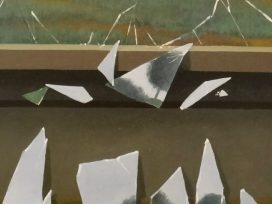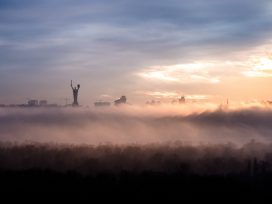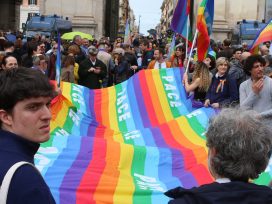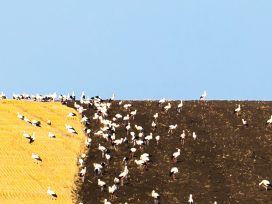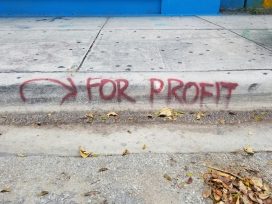Ukraine is a country of alleyways. On the roads that lie parallel to the main thoroughfare of its capital, Kyiv, there’s the daily hubbub of clocking in for work in the morning, the buzz of the cafés at midday and the nightly ritual involving alcohol and live music. The impressive appearance of many of the buildings’ facades conceals any traces in the backstreets of the almost three million inhabitants that commute to work among unstable beams and crowded metro carriages. Looking at the franchises that line the roads connecting the city’s historic districts it’s difficult to get a sense of what’s brewing in the suburbs. It is in those concrete blocks, where thousands of people flocking from Crimea, in the south, which has been annexed by Russia; or from the East, which is at war, take shelter from this unintended lifestyle. That’s what’s caused them to come to the capital so unprepared.
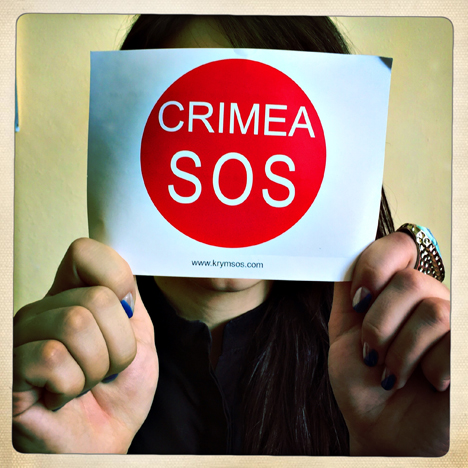
Photo: Alberto G. Palomo
They are refugees in their own land. In bureaucratic jargon they’re referred to as Internally Displaced People (IDP), in other words, people displaced within the borders of their own country. They have a passport like the rest of their compatriots; they speak the same language and share the same idiosyncrasies. However, they’ve had to abandon their homes with nothing but the clothes on the backs and try their luck, often thousands of miles away. Perhaps without the physical fences, the suspicions and the types of controls which afflict Syrians and Africans on a daily basis in central and southern Europe. But at the same time they’re confronted with a wall of an unknown future.
Yet they do face some of the same obstacles. In the case of this country, which was once a part of the Soviet Union and which today has 45,500 inhabitants, like their compatriots in other continents there are two main causes. The main one is the conflict in the Donbass region, which includes the provinces Donetsk and Lugansk, which border the east. A conflict, in reality, a war which has been seldom spoken about since it first broke out 30 months ago. Yet according to the latest UN figures 6,500 people have died. In areas where there are no armed conflicts the other cause is a response to the difficulties of continuing with the previous way of life without pressure, without exhaustive control of each and every activity and still with the types of freedoms that most citizens used to routinely enjoy.
The largest humanitarian organisations have denounced them systematically without little results to date. In June, for example, Médecins Sans Frontières (MSF), sent out an “urgent” shipment of medication for people living on this large alleyway that has become known as the grey zone. The charity’s spokesperson on the ground, Mark Walsh, explains how the ceasefire collapses on a daily basis. ‘The hospitals have been inundated and there’s no infrastructure,’ he said, ‘our work focuses on alleviating stress and helping pensioners and those most in need.”
Following two attempts to put an end to the armed conflict (with the Minsk Protocol in 2014 and a summit that took place in the same Belarusian city in February 2015) the picture painted by MSF doesn’t reflect what’s been agreed: “Every day there are deaths and our actions are complicated by the imposed regulations. Curiously, beforehand we had more access to those at risk. There are more migrations every day,” says Walsh. His account is summed up by 80-year-old Raisa Manko. Trapped on the frontline, she sobs as she recounts the first attacks. “It would have been better to die then and not suffer for months on end. How can I live like this at my age?” she cries.
To put ourselves in her shoes we have to go back to 12 April, 2014 when Russian soldiers launched an offensive to colonise a zone they had reclaimed as their own. Tanks arrived, they seized cities and set up their own governments and it’s even thought that they downed a commercial airplane destined for a beach in Malaysia. As well as cutting short the journey of 283 passengers and 15 crew members, it cut short the lives of more than 100,000 inhabitants in the east of Ukraine. In reality, it changed the situation in the entire country, which had its heart set on building closer ties to Europe after declaring independence from the shackles of Russia 25 years previously. And this was after living through two revolutions since the start of the 21st century. Firstly there was the so-called Orange Revolution in 2004 and subsequently the Revolution of Dignity in 2014.
Normality in wartime
Both revolutions took place in Maidan Nezalezhnosti, the central square that has been the scene of Kyiv’s independence and the symbol of the country’s protests. Both involved thousands of residents from all over the country. In 2004 the revolution was against the lack of transparency in the presidential campaign and in 2014 against the erstwhile president Viktor Yanukovych following a late change to an association agreement brokered with the European Union. Yanukovych was forced to go into hiding, but the problems persevered. The protests gradually died down until they completely vanished from the centre and spread out to the suburbs, to those alleyways where people start to lose their identity. And in those areas where it appears that the conflict has died away, if you were to take a walk past Kyiv’s cathedrals, along the beaches in Odessa or in the historic city centre of Lviv, to name just three significant examples, well nobody would say that Ukraine is a country at war. Despite this, the word dominates every conversation.
In Vostok SOS, an organisation established in May 2014 to assist displaced people in the Donbass region, war is a word that rarely comes up. “Many pro-Ukrainian activists didn’t think it was safe to stay in the occupied areas and don’t have anywhere to work so they had to leave”, says Tatiana Vezbuk, head of communication at the organisation. With the help of North America’s USAID and private donations this initiative established an emergency telephone line for displaced people, providing resources for destitute people across the country. “We give food, clothes or medication and we can provide childcare, sanitation, legal and psychological assistance,” she says.
“The majority of people simply left with only their identity documents and a suitcase”‘, she tells me in a room where a dozen volunteers and employees are organising boxes filled with overcoats and piles of t-shirts, which are then allocated in the basement. “We were with the Maidan protesters for two months but then we stayed by ourselves, with no help,” she says. “Some people have managed to find an apartment and a job, but their legal status continues to be very unstable.” Having registered at their old addresses they find it difficult to get papers processed that grant them the right to claim 850 Ukrainian hryvnia (equivalent to 30.50 euro) in monthly subsidies or to get actively involved in society. “They find it hard to integrate themselves into another city. Every day there’s a dramatic situation, particularly for people that arrive with some kind of illness, without clothes or food and with various family members in tow.”
The number of displaced people is very difficult to measure since they aren’t listed on any sort of register. The writer Alberto Salcedo refers to this type of person as “a margin of error in the census”. “We don’t count them as citizens but rather as low-lives, as if they’ve just snuck out of their lair”, he comments in one of his articles talking about the situation in Colombia. In Ukraine, at the end of 2015 the authorities estimated there were around 30,000 displaced people. By contrast, entities like Vostok SOS estimate this number could easily exceed one million. Cedos, a think-tank set up at the beginning of the war, put the number at 1.7 million in its most recent survey, which it carried out in the first half of 2016.
“77% come from the eastern regions. Even so, the population in this region has grown 7%”, notes Andriy Solodko, a policy analyst at Cedos. Solodko, however, adds that it’s necessary to distinguish between people that are genuinely displaced and those social tourists that move away from where they’re from solely to receive governmental assistance. “In either case, they are invisible. And the reason why they remain invisible is down to the fact that even though many people prefer to remain in the big cities, two-thirds of the total number stay behind in remote areas. They don’t cause a great demographic burden and they are not the ones you see in refugee camps on the television, even though we’ve seen this in Germany. It’s possible to catch a glimpse of them if you walk into hospitals in the suburbs or in rural areas. But they scarcely make the news,” he says.
Furthermore, Cedos believes the government has failed to adopt long-lasting solutions for these refugees. According to its analysis, you need to look at people’s intentions. “They need to know which people want to stay and which want to leave. Sociologically it’s obvious that 70% are thinking of returning in the next 12 months. Some 10% advocate to change province and some 7% go abroad.” Most of the uncertainty, the think-tank says, relates to the fact that displaced people don’t know whether they’re going to stay or whether they’ll be able to return. And this creates a wheel of missteps from the authorities and from the individuals themselves. Of course: around 74% live off government and humanitarian handouts provided by USAID, Acnur or the EU, which 6,000 going towards accommodating them and a further 600,000 in credit towards development.
How do they differ from refugees? “The difference is enormous”, says Andrut, “since basically the IDPs are invisible. They don’t create tensions”. “From the outset the government committed a grave error: it offered grants to everyone that acquired IDP status. So if you’re in the separatist area or in Crimea and you want benefits you can register yourself as a displaced person. Many people join the scheme in this way and leave their homes to retire. If we look, for example, at Kharkiv, which is next to Donbass, we can see that there are more IDPs in the south, closer to Donetsk than in the north.” It’s estimated that around 800,000 are social tourists, although it’s a delicate issue.
Delicate, like everything related to invisible people. Like with ‘The Nobodies’, as Eduardo Galeano used to say. The government has to be cautious with the messages it throws their way so it doesn’t risk raising alarm bells socially or undermining them. NGOs have to tread carefully so their donations aren’t rendered meaningless. Acnur’s Olga Pustovit comes to the conclusion put forward by the latest analysis on refugees by the UN, dated last July: “The situation is very volatile and tense. In the space of a month they’ve given refuge and food to more than 700 people. The OSCE, the body that oversees the EU’s security, denounced it as a continuous violation of the measures of the Minsk Protocol. Each day they help 10,000 people and displaced people’s main worry continues to be the lack of opportunities.”
One shortage that journalist Ryszard Kapuscinski highlighted in his book Imperium: “To live in the provinces means to vegetate, to be a victim of poverty and unemployment. Then there’s the anxiety of moving to a big city, preferably the capital, which offers the prospects of a better life, upward mobility and better job prospects.” A quarter of a century after the collapse of the USSR, the situation today doesn’t look so different. “Ethnic minorities that inhabit Imperium will take advantage of even the lightest winds of democracy to split off, to become independent and to self-govern. For them, when faced with democracy there’s only one response: freedom. A freedom which feels like a separation and which evidently stokes public opposition to power. In order to hold onto their privileged position they’re prepared to use force to resolve problems by authoritarian means.”
Repression in Crimea
The same thing is happening in Crimea. There the situation is very different to in the East. There’s no rule of law and the greatest fear is the tension created by the political changes that have occurred since the region was annexed by Russia in only a matter of hours. The authorities that have been recently brought in put pressure on anyone who does not agree with the new regime. Those that don’t accept the new government run the daily risk of losing their job or suffering punishments that may affect their health. In August we saw the sudden closure of borders, random detention of individuals and accusations of terrorism from the Kremlin. Crimea SOS distinguishes its task from its sister organisation Vostok SOS for several reasons. “In Crimea the activists go out in the early morning, catching the first mode of transport they can find. There are no checkpoints in the war. Other citizens take more time to make up their minds; they’re more organised and continue with their lives as best as they can before leaving,” says a member of the team called Oksana. Since 2014 this support group has helped thousands of people. “Official data suggests that 21,000 people have been expelled, but there are no figures because people simply stopped counting. The unofficial number is around 100,000”, she reckons.
They are faced with the need to provide more and more help and, further down the line, encourage displaced people to get on with setting up their own businesses and become self-sufficient. “The objective now is not only to help people but help them adapt to society. Then they might be able to resolve their problems on their own, so they can feel a part of the city where they live and not be weighed down by another city where they aren’t even living”, she says. “Most people want to return to Crimea and the only reason they’ve left their homes is because they had pro-Ukrainian ideas. In fact, some people are positive and believe the process will change and they’ll be able to return. The mood varies between the young and the old. For the former, it’s an opportunity to start again. But the latter view it as an unwanted delay. “Moreover, the willingness to help society has diminished”, she complains. “There are people who have lost everything and now can bring life back to Ukraine’s economy. When people have nothing to lose they do wonderful things,” she enthuses.
Sabina Iliasova doesn’t take any comfort in this. A few months ago she wanted to be a university lecturer and moved in with some friends in Crimea’s capital Simferopol. At 28 years old her vocation changed: “I used to feel free. Now I feel bad for my parents and I want to become an activist to expose the situation that people like me are in,’ she says, stressing that she isn’t an IDP. “I have a job and money to live on” – two attributes that set her apart from that category. For this young woman born in Uzbekistan and brought to this island in the south of Ukraine at an early age, migration is in her blood.
Of Tatar blood, throughout history her people have survived fleeing their community for other territories. Her training as an economist and her tender age have helped her navigate whatever obstacles have crossed her path: in September 2014 she received a grant from Crimea SOS and built a life for herself in Kyiv. She never thought she would have to escape. “Until 2014 nobody thought we were going to war”, she says. “My parents wanted to come because there are more opportunities here. It was the same for my 26-year-old brother. But they didn’t anticipate what it would be like or what they would do. Crimea is a state of spies: they tap your telephones and monitor you on social networking sites,” she says from her office, which, fortunately, is located in an upmarket building in the north of the city. This is where she’s ended up after walking through the alleyways where citizens from the big city and their invisible compatriots pass like ships in the night.
